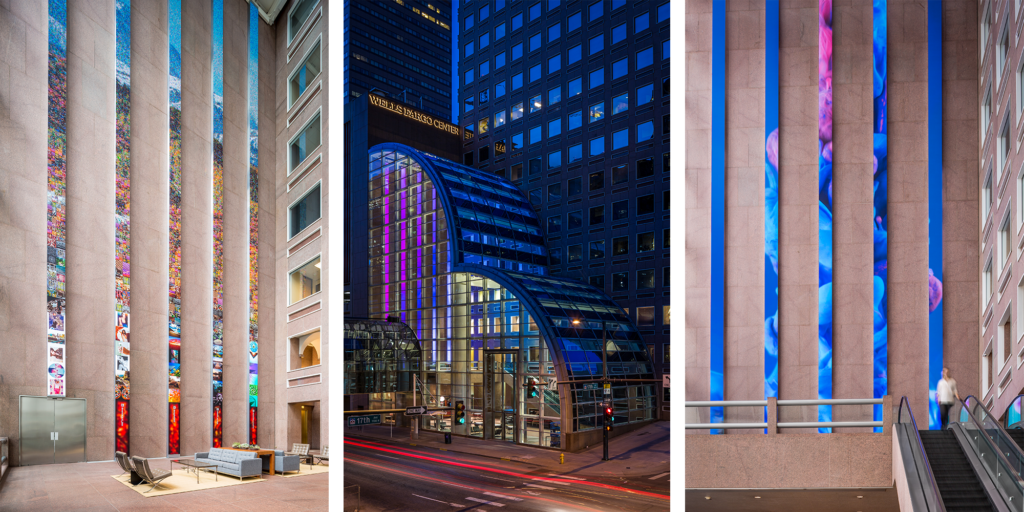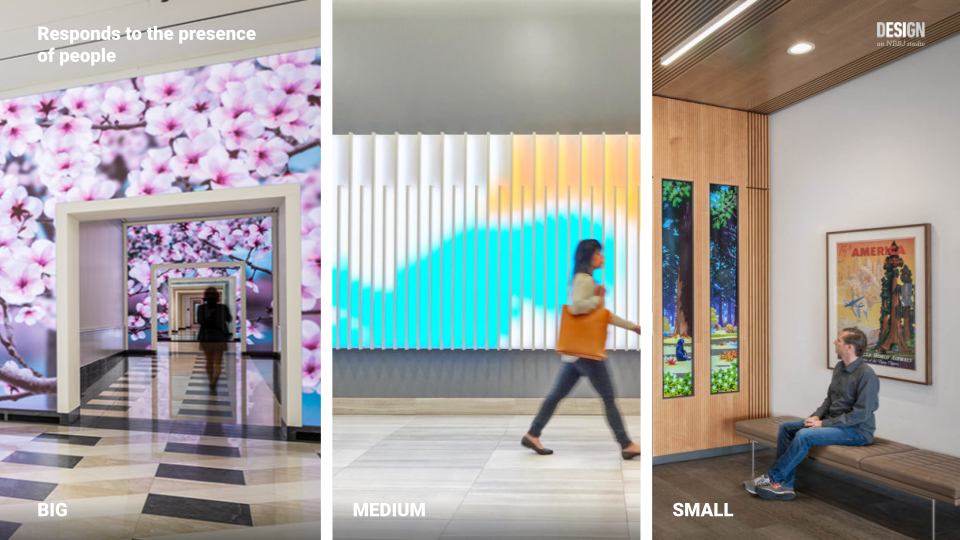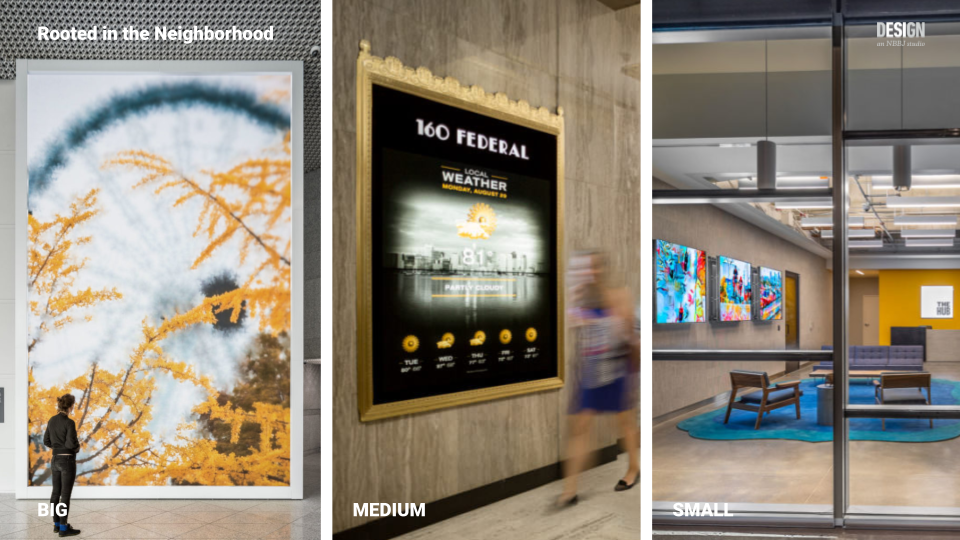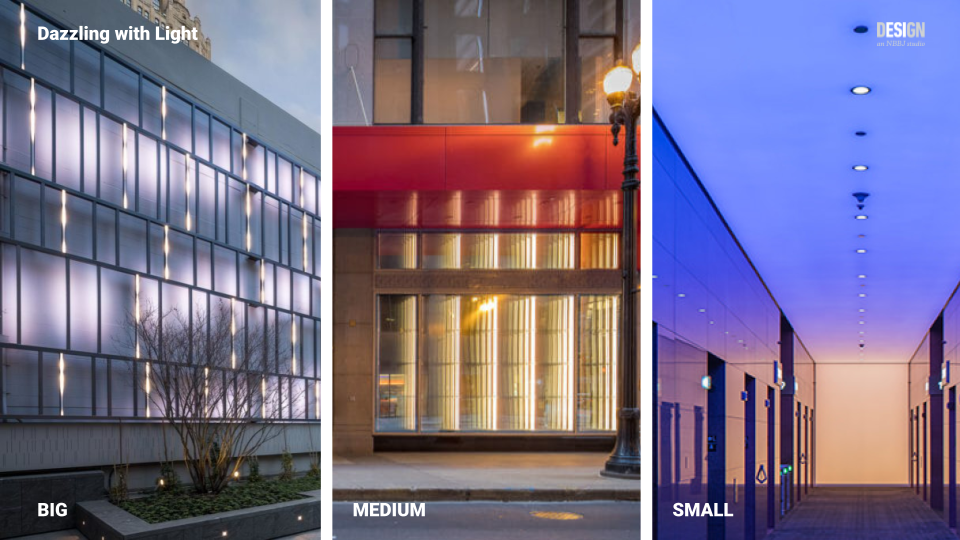Building Repositioning Through Digital Media Installations At Any Scale
Posted February 5, 2021
In Denver’s Wells Fargo Center, the building’s street-level glass atrium features eight-story-tall, floor-to-ceiling LED columns that display dynamic media inspired by the Mile High City, like waterfalls with water that flows based on the city’s current wind patterns. Such impressive, dramatic, large-scale digital media installations have become common in skyscrapers and large office complexes because they create a sense of place, and are a proven draw for tenants. But how can mid-sized and smaller properties use the same concept of digital media installations to reposition their building, increase their value, and compete in a challenging economic landscape?

A smaller property can deliver the same impact through incorporating elements of experience design. Experience design is blending story, physical design, digital media and graphics to create dynamic places at properties of all sizes. With new breakthroughs in LED and other display technologies, as well as increasingly sophisticated software systems, digital media allows owners and developers to transform their lobbies and public areas. Activations can be successful at any scale, creating places that people want to return to every day.
While budget is an obvious consideration in determining the best type of experience for your property, the first element to examine, before thinking about anything else, is your audience. Who will be inhabiting the space? How do we want them to feel as they use and move through the space? What is unique about the neighborhood, and the building’s connection to it? In the case of a lobby, for example, how can a property create a fresh experience for tenants as they enter the same building day after day? And how can the lobby be reimagined as an amenity for them, rather than something they just pass through?
Digital media installations are just one part of the larger experience design story — combined with wayfinding, graphics, furniture and finishes such as paint, a small digital activation can be just as invigorating for a lobby as a massive one. Let’s look at three scalable approaches to digital media installations that can breathe new life into any property while enhancing its identity: reactive/responsive; locally inspired; and light art.
Responds to the presence of people
Digital art that subtly and elegantly responds to human activity can help enhance the natural energy of any space, and when done well can deliver striking and unexpected experiences regardless of size.

BIG
At Washington, D.C.’s Terrell Place, a stunning 1,700-square-foot mural of the city’s iconic cherry trees reacts to passersby with budding flowers, fluttering butterflies, or icicles swinging in the wind, depending on the time of year. By treating the expansive first-floor lobby space as a single media canvas, the installation creates a sense of connection across the building’s common area. A similar effect is achieved at 110 High Street in Boston, where passersby trigger 590-square-foot reactive installations whose various modes include an underwater panorama and playful silhouettes of strolling, dancing, waving people. The media experience extends from the lobby into the street, making the interior and exterior feel more seamless.
MEDIUM
A 50-foot-long art installation covering the walls of the lobby at 44 Montgomery Street adds a motion-activated element that makes the space, located on one of the busiest intersections in San Francisco’s Financial District, feel bright and alive. A suite of sensors turns each person who moves through the lobby into a digital paintbrush, trailing a colored path across a digital canvas whose custom, ribbed surface echoes the fins on the tower’s façade.
SMALL
Though smaller than the above examples, an array of seven vertical LCD panels in each lobby of The Crossroads office campus in San Mateo packs an equally exhilarating visual punch. Set against vintage-style backdrops representing the Redwood Forest, Yosemite National Park, and California’s coastal scenery, a custom video game engine powers a motion-activated, immersive outdoor experience where the sun sets over the Pacific, deer skitter away at the sight of passersby, and an albino bear makes enticingly rare appearances.
Rooted in the Neighborhood
Incorporating local data and imagery into digital installations is a visually engaging way to convey the essence of a property. Whether reflecting real-time weather, celebrating nearby landmarks, or showcasing local artists, captivating visual stories can connect people to a space and provide an invigorating sense of place and openness.

BIG
“Canvas,” a 14-foot-wide-by-23-foot-tall site-specific installation in the lobby of Chicago’s 515 N. State Street, uses custom software to dissolve original video footage of life in the vibrant River North neighborhood into abstract compositions. The daily motion of Chicago, such as boats on the Chicago River and amusement rides on Navy Pier, is rendered into a museum- worthy piece of art that is always evolving.
MEDIUM
At 160 Federal Street, an Art Deco gem in Boston, a new digital directory showcases the history of the building and highlights up-to-the minute information of interest to tenants, such as weather, transit delays, upcoming local events, this day in history, and a poem of the day. The upgrade, which also included enhanced interior and exterior lighting and new branding, boosted occupancy from 85% to 92%.
SMALL
Like “Canvas,” reinventing mounted wall art with digital technology can also be effective on a smaller scale. In the lobbies of The Hub North and South, a commercial complex in Denver’s River North Arts District, an AI-powered triptych uses innovative image-blending software to reimagine photos and videos of Denver landmarks, scenery, and activities in the style of street art by local artists. What at first seems like a trio of still images slowly comes to life in a mesmerizing celebration of the city’s vibrant people and places.
Dazzling with Light
New technologies allow designers to create light art that offers dynamic, ever-changing experiences on unconventional canvases that can be scaled to fit anything from a multi-story wall to a row of windows, and can be truly integrated into the surrounding structure.

BIG
A 95-foot-wide by 25-foot-tall light installation transformed an uninviting outdoor terrace at 151 North Franklin Street in downtown Chicago into a soothing urban oasis that also breathes fresh life into the surrounding streetscape. “Sensing Change” is composed of 390 vertical light bars, and mounted onto the concrete wall of a parking garage which provides an expansive canvas. Gently moving lights that draw on local weather data to create abstract patterns recalling sunlight rippling through trees, rain falling, or clouds scudding across the sky.
MEDIUM
The historic façade of Chicago’s historic 1 North Dearborn was revived with a light-art installation spanning 72 feet of street-level windows and comprising nearly 30,000 LED lights programmed to reflect the ebb and flow of activity in the building. In one of six animation modes, human silhouettes pulse toward the entry, while in the evening they appear to move away, following people as they depart. The window installation also acts as a clock, marking time on the hour with special lighting effects.
SMALL
At One Cal Plaza in Los Angeles, an often overlooked part of the lobby became a soothing light art installation. In the elevator bays, dynamic illuminated surfaces stretch along the ceiling and flow down the back wall. These light surfaces change slowly and subtly through the day with the colors of the southern California sky, from radiant purple to cool blue to warm oranges and pinks.
Final thoughts
Advances in technology are making it possible for properties of all sizes to create memorable experiences at varying scales as part of their building repositioning strategy. But these digital media installations should be seen not as one-off show-stoppers. They are most effective as part of a larger program that is fully integrated into the space. A light touch can deliver just as powerful an impact as an epic-scale piece; digital media is just one component of a holistic experience design approach that works together alongside signage, wayfinding, furniture, and other interior design elements. Technology must be used as a craft rather than a flashy commodity; the objective, regardless of scale, should be to express a building’s story, helping to anchor it to the community and surrounding neighborhood.


Join The Conversation